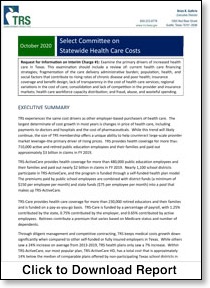TRS: COVID-19 Health Plan Claims
Totaled $62.8 Million through July
The TRS reported this month that the system’s health insurance plans for retirees and active school employees collectively paid $62.8 million in coronavirus-related claims to health providers through July 2020.
The 15-page TRS report to the House Select Committee on Statewide Health Care Costs was made in response to the committee’s request for information for its Interim Charge No. 1 to “examine the primary drivers of increased health care costs in Texas.” (House committees, due to the pandemic, have been accepting written testimony and reports only on their interim charges instead of holding in-person hearings to take live testimony.)
The section of the report devoted to COVID-19 notes that based on TRS health insurance claims paid through July:
- The $62.8 million in total claims were paid on behalf of the more than 6,003 confirmed cases of COVID-19 and an additional 30,228 suspected cases.
- A total of $46.6 million was paid for school employees (and their families) covered under TRS-ActiveCare, and $16.2 million was paid for retirees covered under TRS-Care Standard, the plan for retirees who are not eligible for the TRS-Care Medicare Advantage plan. (COVID-19 data from the Medicare plan was not reported by TRS.)
- The cumulative total of more than 36,231 confirmed and suspected cases for which claims were paid represented 7.6 percent of all enrollees in ActiveCare and TRS-Care Standard plans.

Source: TRS
Will Continue to Have a Significant Impact
The report said that the full, long-term magnitude of the pandemic on TRS is currently unknown at this time — and predicted that COVID-19 will continue to have a significant impact on health care costs and utilization for at least the near future.
“A new vaccine, depending on costs, could have an impact on expenditures in the near future, for example,” the report says.
Increasing Health Care Costs
Meanwhile, the bulk of the report looked at how the TRS is addressing the challenges faced by increasing health care costs.
The report’s good news is that the system provides health insurance coverage for more than 710,000 active and retired public education employees and their families, which has resulted in the system being able to keep the cost for its coverage below what other self-funded employers pay in Texas for employee health insurance coverage.
In Fiscal Year 2018, TRS reduced the cost of its plans by $10 billion through various means, with the biggest reductions realized from $5.2 billion in savings from contracted health provider discounts that the system was able to negotiate.
The report also noted that the system has recently implemented several cost saving measures, including completing the process for contracting with a third-party administrator for both TRS-ActiveCare and TRS-Care that is expected to produce an estimated $754 million in savings for both health insurance programs over the next three-to-five years.
While other Texas employer health insurance providers saw a 24 percent per person increase in rates on average from 2013 to 2019, TRS members only saw a 7 percent increase. New ActiveCare plans that were introduced on Sept. 1, 2020, lowered health insurance costs for families and children by as much as 8 percent.
Other Challenges
But, the report also notes other challenges, in addition to COVID-19.
Despite the market leverage TRS enjoys, the system faces challenges in negotiating with rural markets, where there may be only one hospital — and even in urban markets, where hospital mergers and consolidations have resulted in limiting competition among medical providers, a situation that can be exacerbated when hospitals acquire physician groups and other providers, the report said.
District of Innovation “Loophole”
Among other cited challenges is the fact that some districts are taking advantage of a loophole in state law that allows ISDs, by becoming a District of Innovation (DOI), to optionally offer alternative health care plans to their employees alongside the TRS-ActiveCare plans that they are required to offer.
The report cautions that those alternative plans, while they may be cheaper than the ActiveCare plans, are not comparable to ActiveCare — and often exclude important benefits such as speciality drug coverage, potentially putting members at financial risk.
Also, the prevalence of these alternative plans could disproportionately attract healthier employees, which would in turn drive up the average cost for ActiveCare members overall, creating a risk to the ActiveCare program, the report cautions.
The report notes that it has worked with BCBSTX (Blue Cross Blue Shield of Texas) to communicate the value of TRS-ActiveCare.
The report also takes note of the fact that the Legislature has not increased the state/locally funded $225 minimum ($75 from the state and a minimum of $150 from districts) that must be contributed to employee-only premiums that has been in place since ActiveCare began in 2001 with the goal of reducing most employee-only premiums to $0.
But, based on data from the 2019-20 school year, only 20 percent of employees have a $0 employee contribution for employee-only coverage in the high deductible ActiveCare plan.
As a result, the TRS estimates that school employees on average paid for 46 percent of their total premiums during Fiscal Year 2019, and 60 percent of their medical and pharmacy costs.
TRS-Care
The report briefly examines TRS-Care for retirees by noting that the $231 million the Legislature appropriated in 2019 served to stem what had been expected to be yearly premium increases, allowing the TRS to instead maintain 2018 rates going into the 2021 plan year, “which is not typical of a health care plan.”
